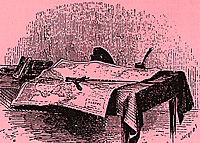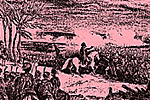Phases of the War
 In the summer of 1805, Napoleon's armies were poised along the French coast near Boulogne for a cross-channel strike. By the end of the year, they had rapidly redeployed to the Rhine, surrounded the Austrians at Ulm, marched down the Danube, occupied Vienna, and then lured the remaining Austrians and their Russian allies to their destruction at Austerlitz. The Tsar, refusing to make peace, pulled his troops back to the motherland.
In the summer of 1805, Napoleon's armies were poised along the French coast near Boulogne for a cross-channel strike. By the end of the year, they had rapidly redeployed to the Rhine, surrounded the Austrians at Ulm, marched down the Danube, occupied Vienna, and then lured the remaining Austrians and their Russian allies to their destruction at Austerlitz. The Tsar, refusing to make peace, pulled his troops back to the motherland.
Too much the general, Napoleon badly handled the diplomacy of France, and failed to conclude thegeneral peace his stunning success ought to have earned. Stung by a humiliating alliance, Prussian pride revulsed upon word of French offers to Britain, and set off the war of 1806, a hopeless death wish made real at jena and Auerstadt. The present study encompasses the clash of armies during the final subjugation of Prussia, between the fall of Berlin in late October 1806 and the Treaty of Tilsit eight months later.
In 1805, just two months sufficed to decide the issue on the Danube. Atthe end of his tether, Napoleon desperately needed to fight at Austerlitz, for active operations could not be sustained much longer. The Russians obliged him in December 1805 because they knew something of the adminiatrative difficulties the french suffered. Even in WWII, with immeasurably grater administrative and support facilities, a general offensive of one month too many months of preparation (wargames which portray units freely attacking all the time across all fronts have disguised this important reality).
Because of the limitations on active operations, only three full-scale battles punctuated the eight months of 1807, along with 10 combats in which either side lost as many at 1,000 casualties. Apart from these were 16 smaller actions, the majority of which occurred in the run-up to the climactic three general engagements. A brief resume of these battles and their losses clearly delineates the three separate campaigns (I, III, and V), divded by two periods when at least some troops of both sides entered winter quarters.
Despite the similarities, by no means did the three campaigns follow the same scenario. Each was fought over difficult terrain. In the first alone did the French advance to contact. The three campaigns had three very diffierent openings, developments, and denouements. The first two resulted in bloody checks to French designs, but the third was decided, before any troops took the field, by the fall of Danzig at the end of May.
 In November of 1806, prior to the start of the campaign, the French troops were occupied in subduing the remaining fortresses alongtheir lines of coimmunications, while the III Corps and cavalry spearheaded an advance deep into Poland. Napoleon intended to seize Warsaw before the onset of Winter. The prize offered two enticements: strategically, it placed the French in favorable position for commencing a spring campaign, and politiclly, it gave Napoleon the chance to raise Polish levies, while denying these to the Russians. The Russians abandoned Warsaw before the advancing French, but with a change of heart, the scrappy bennigsen led them back into the field.
In November of 1806, prior to the start of the campaign, the French troops were occupied in subduing the remaining fortresses alongtheir lines of coimmunications, while the III Corps and cavalry spearheaded an advance deep into Poland. Napoleon intended to seize Warsaw before the onset of Winter. The prize offered two enticements: strategically, it placed the French in favorable position for commencing a spring campaign, and politiclly, it gave Napoleon the chance to raise Polish levies, while denying these to the Russians. The Russians abandoned Warsaw before the advancing French, but with a change of heart, the scrappy bennigsen led them back into the field.
The gauntlet being thrown down, Napoleon accepted, and nearly lost his right arm at Pultusk. Afterwards, while the French rested in their cantonments on the mud-choked Polish plain, bennigsen stole a march and very nearly took off the Emperor's left arm in the north. Had Ney not flagrantly disobeyed orders and advanced into Bennigsen's path, thereby alerting Napoloen to what was afoot, the whole complexion of the campaign might have been changed.
"An army vigorously attacked in cantonment, before it had time to rally, may lose half its force." (Thiers, p. 526). At Eylau, the French were decimated, and from that day began the decline of the army of Austerlitz. Indeed, there was a complete turnover in the ranks by the end of the campaign.
Diplomatic consequences of Russia's Inabaility to Support Danzig
In March, winter commensed in earnest, and neither side dared to venture forth until spring. A relief attempt by Kaminsky (son of Kamenskoi, who commanded the army briefly in December) in Mat 1807 resulted from the Russian and Prussian armies' inability to take the field en masse--the reason being a lack of fodder.
"They thought, therefore, of waiting till the grass was high enough to feed the horse. It was the same reason that detained napoleon on the Passarge. But he had no important fortress to save; every day, onthe contrary, brought him strength." (Thiers, p. 509). Both sides planned to begin operations in June, when the new grass would be high enough.
Negotiations that might have brought Austria into the coalition failed because of bennigsen's inability to support Danzig. With the fall of the great harbor, further coalition resistance was pointless, but within a week, the Russians assaultedthe exposed troops of Ney's command, in the hope of making a brave showing beofre the final peace parley. The goal was fairly accomplished at heilsberg. Had Bennigsen then retired in good order, his sovereign might have been treated on a more equal footing at Tilsit.
- To wait for Napoleon on the Pregel, the right on Konigsberg, left on Wehlau, to fall back in good order upon the Nieman, to entice the French into the recesses of the empire, avoiding great battles, woud have been the only rational conduct on the part o the Russian general, and as subsequent experience has shown, the only wise course. (Thiers, p.527).
The Opposing Armies In this great contest of 1807, the advantages of the opposing troops tended to cancel each other and campaigning led only to bloody stalemated battles. Attacking suited the active and intelligent French infantry and helpoed the flexibility of their formations and quick reactions to tell most effectively. The solid and unshakable Russian soldier, with a strong faith in his sovereign and plenty of vodka, was an immoveable object on the defensive. With the infantry thus gridlocked, battles often became great artillery duels, and this campiagn saw the first massed-batteries employed.
The Cossacks proved their worth in this terrain; armed with lances, they terrorized the French. These hardy warriors, like their horses inured to the hardships of all sorts, felt but little the starvation and cold. At the outposts of the armies in cantonment, the Cossacks were a continual embarrassement to the french light cavalry.
"Accustomed from childhood to the use of the lance, the Cossack was more than a match to the horseman armed only with a sword, or for any but a very expert lancer." (Petre p. 35). They could strike tellingly if the cavalry had just charged, especially heavy cavalry. After passing through Russian infantry--exhausted, their horses blown--the French cuirassiers crumbled and suffered terribly before a charge of Cossacks. (Petre, p. 34).
Russian Infantry Division
Bennigsen's Army (December 1806)| Unit Type | Composition | Men | Total Bttns | Total Men | Guns |
|---|---|---|---|---|---|
| Infantry Regiments | 3 Bttns | 660 | 6x3=18 | 11,880 | - |
| Heavy Cavalry | 10 Sqdns | 132 | - | 1,320 | - |
| Light Cavalry | 10 Sqdns | 132 | - | 1,320 | - |
| Heavy Artillery | 2 Batts | 120 | - | 240 | 24 |
| Light Artillery | 3 Batts | 120 | - | 360 | 36 |
| Horse Artillery | 1 Batt | 90 | - | 90 | 9 |
| Total | - | - | - | 15,210 | 69 |
The four divisions at this strengths, the 2nd, 3rd, 4th, and 6th, totaled 47,500 infantry, 11,000 cavalry, and 2,700 artillerists manning 276 guns. In addition, bennigsen had 4,000 Cossacks, three HQ bttns., and 900 pioneers/engineers. He lost 80 guns (5 strength points) of artillery during the retirement to Pultusk/Golymin in December (Petre, p. 34).
Russian Infantry Division
Buxhowden's Army (December 1806)| Unit Type | Composition | Men | Total Bttns | Total Men | Guns |
|---|---|---|---|---|---|
| Infantry Regiments | 3 Bttns | 400 | 6x3=18 | 7,200 | - |
| Heavy Cavalry | 10 Sqdns | 84 | - | 840 | - |
| Light Cavalry | 10 Sqdns | 842 | - | 840 | - |
| Heavy Artillery | 2 Batts | 50 | - | 100 | 18 |
| Light Artillery | 3 Batts | 50 | - | 150 | 27 |
| Horse Artillery | 1 Batt | 50 | - | 50 | 9 |
| Total | - | - | - | 9,180 | 54 |
The 5th, 7th, 8th, and 14th divisions followed this table--depleted after Austerlitz--comprise 29,000 infantry, 7,000 cavaley, and 1,200 artillerists manning 216 guns (Petre, p. 37).
Outline of 1807 Campaign
French Army Strengths by Corps in table format (Oct-Jun).
Other Articles in the Series
Back to Art of War Annual Issue #23/24 Table of Contents
© Copyright 1996 by Clash of Arms Games.
This article appears in MagWeb (Magazine Web) on the Internet World Wide Web.
Other military history articles and gaming articles are available at http://www.magweb.com